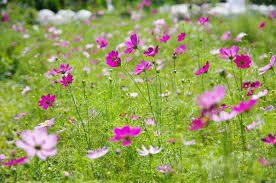**Cosmos Flowers and Their Contribution to Environmental Conservation**

In the realm of environmental conservation, cosmos flowers emerge as unsung heroes, offering valuable contributions to the protection and preservation of our natural world. Beyond their aesthetic appeal, cosmos flowers play a crucial role in enhancing biodiversity, supporting pollinators, and promoting sustainable land management practices. In this article, we’ll explore the multifaceted ways in which cosmos flowers contribute to environmental conservation efforts, highlighting their importance in safeguarding ecosystems and promoting a healthier planet for future generations.
**1. Biodiversity Enhancement:**
Cosmos flowers are champions of biodiversity, enriching landscapes with their vibrant blooms and diverse array of colors. As flowering plants, they provide essential habitat and food sources for a wide range of pollinators, including bees, butterflies, and hummingbirds. By attracting pollinators to gardens, parks, and natural habitats, cosmos flowers contribute to the maintenance of diverse plant communities and the conservation of biodiversity.
**2. Pollinator Support:**
One of the most significant contributions of cosmos flowers to environmental conservation is their role in supporting pollinators. Pollinators play a crucial role in the reproduction of flowering plants and the maintenance of healthy ecosystems. Cosmos flowers provide nectar and pollen to pollinators, helping to sustain their populations and ensure the continued pollination of wildflowers, crops, and other plant species. By supporting pollinator populations, cosmos flowers contribute to the health and resilience of ecosystems.
**3. Wildlife Habitat Creation:**
Cosmos flowers serve as important habitat creators, providing shelter, nesting sites, and food sources for a variety of wildlife species. In addition to pollinators, cosmos flowers attract insects, birds, and small mammals that rely on them for food and habitat. Their foliage provides cover for wildlife, while their nectar-rich blooms attract beneficial insects such as ladybugs and predatory wasps, which help control pest populations. By creating diverse habitats within ecosystems, cosmos flowers support the survival and biodiversity of wildlife.
**4. Soil Conservation:**
The cultivation of cosmos flowers can contribute to soil conservation efforts by promoting sustainable land management practices. Their deep root systems help prevent soil erosion by stabilizing the soil and reducing runoff. Additionally, cosmos flowers can be planted as cover crops or in mixed-species plantings to improve soil health and fertility. By enhancing soil structure and reducing erosion, cosmos flowers contribute to the conservation of soil resources and the protection of fragile ecosystems.
**5. Water Conservation:**
Cosmos flowers play a role in water conservation by promoting water-efficient gardening practices and reducing the need for irrigation. Native species of cosmos are adapted to thrive in arid and semi-arid climates, making them well-suited for drought-tolerant landscaping. By incorporating cosmos flowers into landscapes and gardens, homeowners and land managers can create water-wise habitats that require minimal irrigation and support local ecosystems.
**6. Sustainable Landscaping Practices:**
The use of cosmos flowers in landscaping promotes sustainable land management practices that benefit the environment. Cosmos flowers are well-suited for low-maintenance landscapes, requiring minimal inputs such as water, fertilizer, and pesticides. Their drought tolerance, disease resistance, and ability to thrive in diverse soil conditions make them ideal candidates for sustainable landscaping projects. By incorporating cosmos flowers into green spaces, urban areas, and public parks, communities can create beautiful, resilient landscapes that support biodiversity and environmental conservation.
**7. Education and Awareness:**
Cosmos flowers serve as powerful educational tools for raising awareness about environmental conservation and biodiversity. Through gardening programs, educational workshops, and public outreach events, individuals and communities can learn about the importance of pollinators, native plants, and sustainable gardening practices. By showcasing the beauty and ecological value of cosmos flowers, educators and environmentalists can inspire others to take action in protecting and preserving our natural heritage.
**8. Ecotourism and Recreation:**
Cosmos flowers contribute to ecotourism and recreational activities by attracting visitors to natural areas and green spaces. Nature enthusiasts and tourists flock to parks, botanical gardens, and wildflower meadows to admire the beauty of cosmos blooms and observe pollinators in action. By supporting ecotourism initiatives and preserving natural habitats where cosmos flowers grow, communities can generate economic benefits while promoting environmental conservation and appreciation for nature.
In conclusion, cosmos flowers play a vital role in environmental conservation efforts, contributing to biodiversity enhancement, pollinator support, habitat creation, soil conservation, and water management. By incorporating cosmos flowers into landscapes, promoting sustainable gardening practices, and raising awareness about their ecological value, we can harness the power of nature to protect and preserve our precious natural resources for future generations. As stewards of the Earth, let us embrace the beauty and significance of cosmos flowers in our efforts to build a more sustainable and resilient planet.
